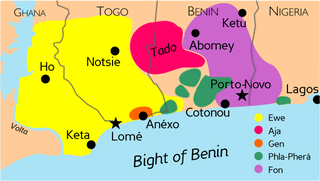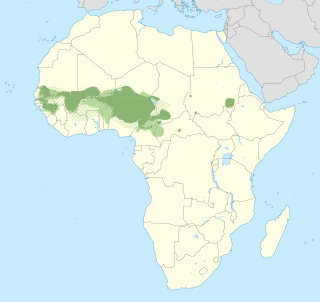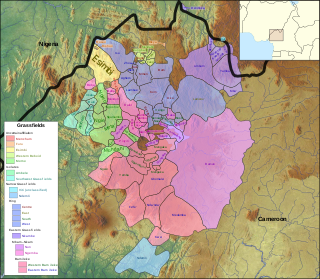Related Research Articles

Hausa is a Chadic language spoken by the Hausa people in Chad, and mainly within the northern half of Nigeria, Ghana, Cameroon, Benin and the southern half of Niger, with significant minorities in Sudan and Ivory Coast.

The Senufo or Senufic languages has around 15 languages spoken by the Senufo in the north of Ivory Coast, the south of Mali and the southwest of Burkina Faso. An isolated language, Nafaanra, is also spoken in the west of Ghana. The Senufo languages constitute their own branch of the Atlantic–Congo sub-family of the Niger–Congo languages. Garber (1987) estimates the total number of Senufos at some 1.5 million; the Ethnologue, based on various population estimates, counts 2.7 million. The Senufo languages are bounded to the west by Mande languages, to the south by Kwa languages, and to the north and east by Central Gur languages.

The Gur languages, also known as Central Gur or Mabia, belong to the Niger–Congo languages. They are spoken in the Sahelian and savanna regions of West Africa, namely: in most areas of Burkina Faso, and in south-central Mali, northeastern Ivory Coast, the northern halves of Ghana and Togo, northwestern Benin, and southwestern Niger. A few Gur languages are spoken in Nigeria. Additionally, a single Gur language, Baatonum, is spoken in Benin and in the extreme northwest of Nigeria. Three other single Gur languages, the Tusya, Vyemo and Tiefo languages, are spoken in Burkina Faso. Another unclassified Gur language, Miyobe, is spoken in Benin and Togo. In addition, Kulango, Loma and Lorhon, are spoken in Ghana, Ivory Coast and Burkina Faso. Additionally, a few Mossi speakers are in Senegal, and speakers of the Dagaare language are also found in Cameroon. The Samu languages of Burkina Faso are Gur languages.

The Tuareg languages constitute a group of closely related Berber languages and dialects. They are spoken by the Tuareg Berbers in large parts of Mali, Niger, Algeria, Libya and Burkina Faso, with a few speakers, the Kinnin, in Chad.

Ewe is a language spoken by approximately 20 million people in West Africa, mainly in Ghana, Togo and Benin, and also in some other countries like Liberia and southwestern Nigeria. Ewe is part of a cluster of related languages commonly called the Gbe languages. The other major Gbe language is Fon, which is mainly spoken in Benin. Like many African languages, Ewe is tonal as well as a possible member of the Niger-Congo family.

The Manding languages are a dialect continuum within the Mande language family spoken in West Africa. Varieties of Manding are generally considered to be mutually intelligible – dependent on exposure or familiarity with dialects between speakers – and spoken by 30 to 40 million people in the countries Burkina Faso, Senegal, Guinea-Bissau, Guinea, Liberia, Ivory Coast and the Gambia. Their best-known members are Mandinka or Mandingo, the principal language of The Gambia; Bambara, the most widely spoken language in Mali; Maninka or Malinké, a major language of Guinea and Mali; and Jula, a trade language of the northern Ivory Coast and western Burkina Faso. Manding is part of the larger Mandé family of languages.

The Mandinka language or Mandingo, is a Mande language spoken by the Mandinka people of Guinea, northern Guinea-Bissau, the Casamance region of Senegal, and in The Gambia where it is one of the principal languages.

Nafaanra, also known as Nafanan or Nafana, is a Senufo language spoken in northwest Ghana, along the border with Ivory Coast, east of Bondoukou. It is spoken by approximately 61,000 people. Its speakers call themselves Nafana, but others call them Banda or Mfantera. Like other Senufo languages, Nafaanra is a tonal language. It is somewhat of an outlier in the Senufo language group, with the geographically-closest relatives, the Southern Senufo Tagwana–Djimini languages, approximately 200 kilometres (120 mi) to the west, on the other side of Comoé National Park.

Supyire, or Suppire, is a Senufo language spoken in the Sikasso Region of southeastern Mali and in adjoining regions of Ivory Coast. In their native language, the noun sùpyìré means both "the people" and "the language spoken by the people".
In linguistics, a chroneme is a basic, theoretical unit of sound that can distinguish words by duration only of a vowel or consonant. The noun chroneme is derived from Ancient Greek χρόνος (khrónos) 'time', and the suffixed -eme, which is analogous to the -eme in phoneme or morpheme. However, the term does not have wide currency and may be unknown even to phonologists who work on languages claimed to have chronemes.

Fula, also known as Fulani or Fulah, is a Senegambian language spoken by around 30 million people as a set of various dialects in a continuum that stretches across some 18 countries in West and Central Africa. Along with other related languages such as Serer and Wolof, it belongs to the Atlantic geographic group within Niger–Congo, and more specifically to the Senegambian branch. Unlike most Niger-Congo languages, Fula does not have tones.
Kusasi is a Gur language spoken primarily in northern Ghana, and Burkina Faso. It is spoken by over 150,000 people and takes its name from the Kusasi people. There are some Speakers of Kusaasi in Togo. Kusaal is closely related to Mampruli, the language of the Mamprussi, who live to the south, and to Dagbani. There is a major dialect division between Agole, to the east of the Volta river, and Toende, to the West. Agole has more speakers, and the only large town of the district, Bawku, is in Agole. The New Testament translation is in the Agole dialect.

The Senari languages form a central dialect cluster of the Senufo languages. They are spoken in northern Ivory Coast, southern Mali and southwest Burkina Faso by more than a million Senufo. Three varieties can be distinguished,
The Manenguba languages, also known as the Mbo cluster, are a group of closely related Bantu languages spoken on and around the Manenguba mountain range in south-western Cameroon.
Ikwerre, sometimes spelt as Ikwere, is a type of Igboid language spoken primarily by the Ikwerre people, who inhabit certain areas of Rivers State, Nigeria. It is the biggest Igboid variety along with Ngwa of Abia State.
Koromfe is a Gur language spoken in a U-shaped area around the town of Djibo, in the north of Burkina Faso and southeastern Mali, bordering Dogon Country.
Siwu is spoken in the mountainous central part of the Volta Region of Ghana. It belongs to the geographic group of Ghana Togo Mountain languages of the Kwa branch of Niger–Congo. The speakers of Siwu call themselves the Mawu and their land Kawu.
Bariba, also known as Baatonum, is the language of the Bariba people of Benin and Nigeria and was the language of the state of Borgu.
Tommo So is a language spoken in the eastern part of Mali's Mopti Region. It is placed under the Dogon language family, a subfamily of the Niger-Congo language family.

Babanki, or Kejom, is the traditional language of the Kejom people of the Western Highlands of Cameroon.